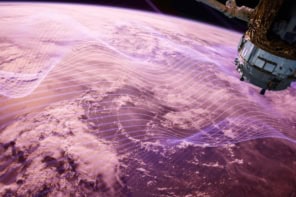The air bubbles trapped in water that are responsible for the hypnotic sound of breaking waves have been scrutinized by two scientists in California. Grant Deane and Dale Stokes of the Scripps Institute of Oceanography have discovered that the bubbles fall into two categories - large and small - that are created by different mechanisms. Since the size of these bubbles influences the way gases travel between the ocean and the atmosphere, the research could lead to more accurate models of global climate (G B Deane and M D Stokes 2002 Nature 418 839).
Bubbles in the upper ocean that are tens or hundreds of seconds old are fairly well understood, but few measurements have been made on bubbles in the few seconds after they have been formed by breaking waves. Deane and Stokes measured the size distributions of these bubbles by studying video and photographic images of breaking waves in a tank full of sea water in their laboratory, which is part of the University of California at San Diego. They found that for bubbles with a radius smaller than one millimetre, the number of bubbles per unit volume was proportional to the bubble radius raised to the power of -3/2. However, the number of larger bubbles was proportional to the radius raised to the power of -10/3.
The researchers say that this cut-off point exists because of the way that bubbles break up. They argue that bubbles fragment when the pressure exerted on them by turbulence is greater than their own surface tension. Therefore, in a turbulent flow of a given strength, bubbles smaller than the cut-off point will be stable, whereas larger bubbles will tend to break up.
Deane and Stokes believe bubbles larger than one millimetre in radius are formed when waves curl over on themselves and the resulting air cavity collapses. They also think that smaller bubbles are caused by the splash of the wave’s tip hitting the surface of the sea.
Understanding how such waves are formed will improve scientists’ understanding of a number of physical, chemical and biological processes that occur at the interface between the sea and the air. For example, since bubbles carry carbon dioxide into the sea, they affect the rate at which algae grows and therefore partly determine how well the ocean can absorb this gas from the atmosphere.
In addition, when bubbles float to the surface of the sea they burst and throw tiny droplets into the atmosphere, which ultimately influences the formation of clouds and hurricanes. Bubbles also transport organic material and bacteria up to the ocean surface, and both create and scatter underwater sound.



